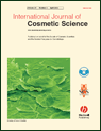A reciprocal lattice approach to assessing the luster of hair fibers, based on scattering by periodically deformed cylinders
Abstract
In a recent prize-winning study, Nagase et al. presented an analysis, using geometrical optics, of the perception of luster of hair based on the different directions of light reflection from the front and internal rear surfaces of the fiber. These two reflections, from cuticle cells inclined to the fiber axis, lead to a specular peak and an associated bright zone, displaced in reflection angle, which is associated with luster perception. This work built upon the experimental observations of Bustard and Smith. Both these papers employed a model of the fiber which may be described as a linear stack of cone frusta, defined by the exposed axial length and angle of inclination to the fiber axis of the cuticle scales. This fiber model is readily amenable to an alternative treatment, in which the model is recognized as a convolution of a cone frustum with a one-dimensional lattice. The scattering properties are then given in reciprocal (scattering) space as the product of the scattering function of a single frustum and that of the one-dimensional lattice. This problem was addressed, in principle, long ago by Bear and Bolduan in work on the scattering of periodically distorted collagen fibrils. The author presents a related theory based on conical shells. It is demonstrated that the scattering from such a model extends over a number of non-equatorial reciprocal lattice planes and is able to reproduce, in a crudely quantitative fashion, several of the features of the experimentally observed scattering. A major benefit of this approach is that it gives a three-dimensional appreciation of light scattering by fibers.




